
- Alma Thomas
- Alma Woodsey ThomasAlma W. Thomas
- Columbus, Georgia 1891
- Washington, District of Columbia 1978
- American
During the 1960s Alma Thomas emerged as an exuberant colorist, abstracting shapes and patterns from the trees and flowers around her. Her new palette and technique—considerably lighter and looser than in her earlier representational works and dark abstractions—reflected her long study of color theory and the watercolor medium.
Red Sunset, Old Pond Concerto [SAAM, 1977.48.5] emphasizes the intensity of a sunset as it overtakes a landscape, penetrating layers of greenery to strike darkening water. Broken rows of color pats, a hallmark of her mature style, alternate with emphatic vertical bands. Their irregular intervals create a visual rhythm akin to music, while dappled reds, greens, and blue-blacks orchestrate subtle nuances and dramatic contrasts. Thomas frequently talked about “watching the leaves and flowers tossing in the wind as though they were singing and dancing.” She also liked to imagine seeing natural forms from a plane. Her lyrical interpretation of a pond at sunset suggests a blending of these two perspectives.
As a black woman artist, Thomas encountered many barriers; she did not, however, turn to racial or feminist issues in her art, believing rather that the creative spirit is independent of race or gender. In Washington, D.C., where she lived and worked after 1921, Thomas became identified with Morris Louis, Gene Davis, and other Color Field painters active in the area since the 1950s. Like them, she explored the power of color and form in luminous, contemplative paintings.
Lynda Roscoe Hartigan African-American Art: 19th and 20th-Century Selections (brochure. Washington, D.C.: National Museum of American Art)
“Man’s highest aspirations come from nature. A world without color would seem dead. Color is life. Light is the mother of color. Light reveals to us the spirit and living soul of the world through colors.”—Press Release, Columbus Museum of Arts and Sciences, 1982, for an exhibition entitled A Life in Art: Alma Thomas 1891–1978, Vertical File, Library, National Museum of American Art, Smithsonian Institution, Washington, D.C.
Alma Thomas began to paint seriously in 1960, when she retired from her thirty-eight year career as an art teacher in the public schools of Washington, D.C. In the years that followed she would come to be regarded as a major painter of the Washington Color Field School.
Born on September 22, 1891, in Columbus, Georgia, Thomas was the eldest of four daughters. Her father worked in a church and her mother was a seamstress and homemaker. Thomas’s family was well respected in Columbus, and she and her sisters grew up in comfortable surroundings. The family lived in a large Victorian house high on a hill overlooking the town where Thomas spent her childhood observing the beauty and color of nature. In 1907, when Thomas was fifteen years old, her father moved the family to Washington, D.C. She enrolled in Howard University, and in 1924 became the first graduate of its newly formed art department. Thomas’s teacher and mentor, James V. Herring, granted her use of his private art library, from which she gained a thorough background in art history. A decade later, she earned a Master of Arts degree in education from Columbia University.
During the 1950s Thomas attended art classes at American University in Washington. She studied painting under Joe Summerford, Robert Gates, and Jacob Kainen, and developed an interest in color and abstract art. Throughout her teaching career she painted and exhibited academic still lifes and realistic paintings in group shows of African-American artists. Although her paintings were competent, they were never singled out for individual recognition.
Suffering from the pain of arthritis at the time of her retirement, she considered giving up painting. When Howard University offered to mount a retrospective of her work in 1966, however, she wanted to produce something new. From the window of her house she enjoyed watching the ever-changing patterns that light created on her trees and flower garden. So inspired, her new paintings passed through an expressionist period, followed by an abstract one, to finally a nonobjective phase. Many of Thomas’s late-career paintings were watercolors in which bold splashes of color and large areas of white paper combine to create remarkably fresh effects, often accented with brush strokes of India ink.
Although Thomas progressed to painting in acrylics on large canvases, she continued to produce many watercolors that were studies for her paintings. Thomas’s personalized mature style consisted of broad, mosaic-like patches of vibrant color applied in concentric circles or vertical stripes. Color was the basis of her painting, undeniably reflecting her life-long study of color theory as well as the influence of luminous, elegant abstract works by Washington-based Color Field painters such as Morris Louis, Kenneth Noland, and Gene Davis.
Thomas was in her eighth decade of life when she produced her most important works. Earliest to win acclaim was her series of Earth paintings—pure color abstractions of concentric circles that often suggest target paintings and stripes. Done in the late 1960s, these works bear references to rows and borders of flowers inspired by Washington’s famed azaleas and cherry blossoms. The titles of her paintings often reflect this influence. In these canvases, brilliant shades of green, pale and deep blue, violet, deep red, light red, orange, and yellow are offset by white areas of untouched raw canvas, suggesting jewel-like Byzantine mosaics.
Man’s landing on the moon in 1969 exerted a profound influence on Thomas, and provided the theme for her second major group of paintings. In 1969 she began the Space or Snoopy series so named because “Snoopy” was a term astronauts used to describe a space vehicle used on the moon’s surface. Like the Earthseries these paintings also evoke mood through color, yet several allude to more than a color reference. In Snoopy Sees a Sunrise of 1970, she placed a circular form within the mosaic patch of colors and accented it with curved bands of light colors. Blast Off depicts an elongated triangular arrangement of dark blue patches rising dramatically and evocatively against a background of pale pinks and oranges. The majority of Thomas’s Space paintings are large sparkling works with implied movement achieved through floating patterns of broken colors against a white background.
In her last paintings, Thomas employed her characteristic short bars of color and impasto technique. The tones, however, became more subdued, and the formerly vertical and horizontal accents of Thomas’s brush strokes became more diverse in movement, and included diagonals, diamond shapes, and asymmetrical surface patterns. During the artist’s final years, the crippling effects of arthritis prevented her from painting as often as she wanted.
Alma Thomas never married, and lived in the same house her father bought in downtown Washington in 1907. The final years of her life brought awards and recognition. In 1972 she was honored with one-woman exhibitions at the Whitney Museum of American Art and at the Corcoran Gallery of Art; that same year one of her paintings was selected for the permanent collection of the Metropolitan Museum of Art in New York City. Before her death in 1978, Thomas had achieved national recognition as a major woman artist devoted to abstract painting.
Alma Woodsey Thomas (1891-1978)
In 1907, Thomas and her family migrated from Columbus, Georgia, to DC, and by 1924, she became the first art department graduate at Howard University. She studied the latest developments in art, visiting museums in New York, Europe, and DC, including The Phillips Collection. For 35 years and in a segregated city, she empowered art students at Shaw Junior High School to see beauty in the everyday and brought exhibition opportunities and cultural enrichment to Black youth. Thomas’s home at 1530 15th Street, NW, was her artistic epicenter. There, she created small watercolors, aerial landscapes, and brightly patterned large-scale abstractions that reflect her local surroundings and her fascination with space and the environment. She also pursued her interests in performance, puppetry, and fashion. A leader within her creative community, Thomas shaped the DC art scene through her association with Howard University, American University, and the Barnett Aden Gallery (one of the first Black-owned private galleries in the nation), which she helped co-found. She made history in 1971 by becoming the first Black woman given a solo show at the Whitney Museum of American Art in New York at age 81, and again in 2015 by becoming the first Black woman to have a work of art acquired by the White House Collection.
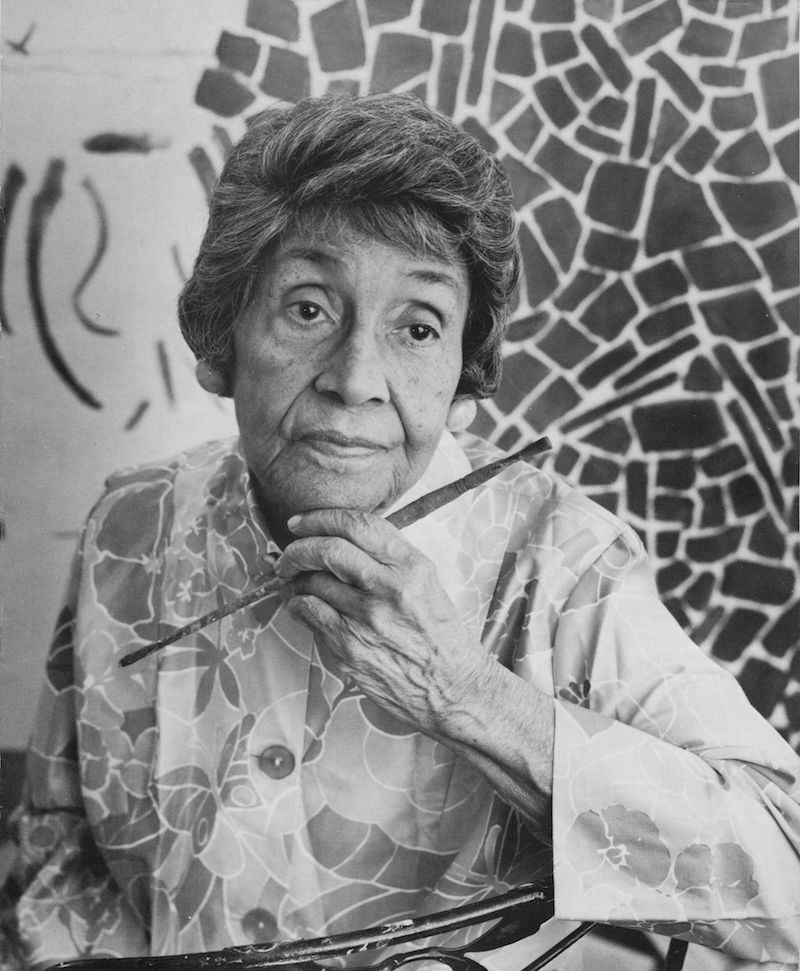
Portrait of Alma Thomas © Michael Fischer, 1976. Courtesy of the Smithsonian American Art Museum
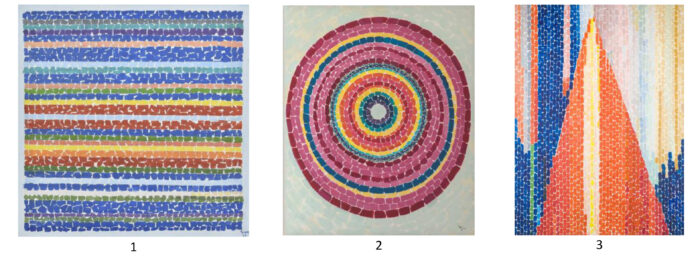
Image Credits
1. Alma W. Thomas. Air View of a Spring Nursery, 1966. Acrylic on canvas. The Columbus Museum, museum purchase and gift of the National Association of Negro Business Women, and the artist
2. Alma W. Thomas. Spring Flowers Near Jefferson Memorial, 1970. Acrylic on canvas. Fisk University Galleries, Fisk University, Nashville, Tennessee, 1991.2116
3. Alma W. Thomas. Blast Off, 1970. Acrylic on canvas. Smithsonian National Air and Space Museum, Washington, DC, Gift of Vincent Melzac
The Frist Art Museum presents Alma W. Thomas: Everything Is Beautiful, a comprehensive overview of the artist’s long, dynamic life (1891–1978) and multifaceted career that was defined by constant creativity. Featuring more than 150 works, including her joyful and colorful abstract paintings and many objects that have never been exhibited or published before, the exhibition demonstrates how Thomas’s artistic practices extended to every aspect of her life—from community service and teaching to gardening and dress. Co-organized by the Chrysler Museum of Art and The Columbus Museum, Georgia, Everything Is Beautiful will be on view in the Frist’s Upper-Level Galleries from February 25 through June 5, 2022.
This major retrospective follows the trailblazing artist’s journey from Columbus, Georgia, to Washington, DC, to becoming the first Black woman to have a solo show at New York’s Whitney Museum of American Art in 1972, when she was eighty years old. It includes thirty-eight canvases spanning 1922–77, more than sixty works on paper, four marionettes, and a range of sculptures, photographs, and ephemera. “The Columbus Museum collection includes an extraordinary body of material related to Thomas, thanks to gifts from her family, particularly her sister John Maurice Thomas,” said Jonathan Frederick Walz, PhD, director of curatorial affairs and curator of American art at The Columbus Museum. “By sharing a selection of these objects, many of which haven’t been seen outside of Georgia, we hope to offer new insights into Thomas’s diverse body of work.”
“Everything Is Beautiful not only provides a more complex understanding of Alma Thomas, but also offers an inspiring example of how to lead a creative life today,” says Seth Feman, PhD, one of the exhibition’s curators and the Chrysler’s deputy director for art and interpretation and curator of photography. He notes that, while Thomas has been long adored by collectors and scholars, her talent remained unfamiliar to a wider public for more than three decades after her death until 2009, when President Barack Obama and First Lady Michelle Obama included her work among the paintings they installed at the White House.
The exhibition explores Thomas’s relationship to the Washington Color School, the creative communities connected to Howard University, and peers who protested museums that failed to exhibit artists of color. “Throughout her career, the art departments and galleries of historically Black colleges and universities provided Thomas with vital support,” says Frist Art Museum senior curator Trinita Kennedy. “Her closest connections were with Howard University, her alma mater, and the place where she debuted her abstract style—what she called ‘Alma stripes’—in 1966. That exhibition marked the beginning of her meteoric rise in the art world.”
Moving through the galleries, guests will encounter the archetypal spaces where Thomas expressed her creativity, including the studio, the garden, the theater, community sites such as schools and churches, universities, and the art scene that extended from Washington, DC, to New York and beyond through the Art in Embassies Program. Thomas’s presence will also be invoked through recreations of her distinctive dresses with bold, geometric patterns, a new documentary about her life and career, and the music she listened to while she painted. A playlist accessible at the start of the exhibition allows visitors to hear the artist’s favorite songs, including the Ray Stevens hit “Everything Is Beautiful,” recorded in Nashville in 1970. The audio tour was written by The Phillips Collection, and there will also be a touchscreen interactive that offers guests the opportunity to explore Thomas’s past landmark exhibitions.
The Frist is one of four museums presenting this tribute to Thomas. “Here in Nashville, special attention will be given to Thomas’s 1971 exhibition organized by David C. Driskell at Fisk University’s Carl Van Vechten Art Gallery,” says Kennedy. “It was Driskell who brought Thomas to the attention of the Whitney Museum, and the two shows have much in common.” Everything Is Beautiful begins with a partial restaging of the 1972 Whitney show, including a recreation of the dress Thomas commissioned to complement her art and wore to the opening.
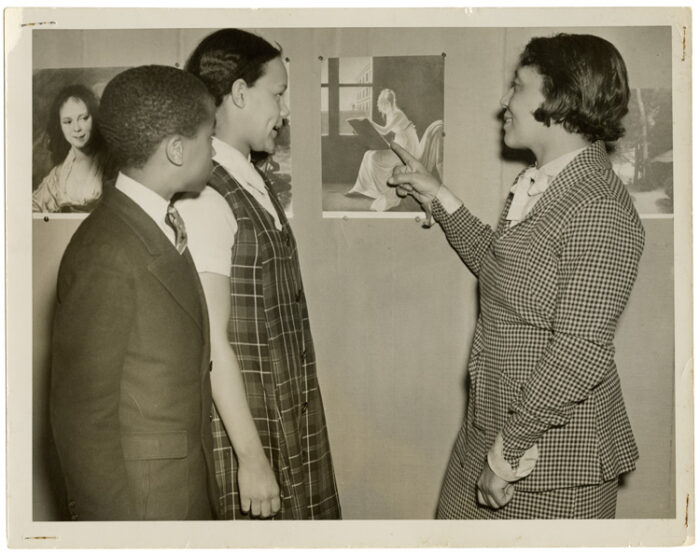
The success of Thomas’s final, remarkable years tends to overshadow her previous decades of devotion to various local organizations, her diverse creative interests, and how she viewed the natural world as an enduring source of inspiration. The titles and forms of Thomas’s beloved abstract paintings demonstrate her interest in flora and fauna, music, space travel, and spirituality.
“Thomas achieved artworld stardom but considered teaching art to be her greatest legacy,” says Kennedy. The Frist will highlight Thomas’s thirty-five-year tenure at Shaw Junior High in Washington, DC, by presenting a concurrent exhibition titled Nashville Art Teachers: Beyond the Classroom that salutes the extraordinary art teachers in our own community and their heroic efforts during the challenging circumstances of the COVID-19 pandemic. It features the work of elementary, middle, and high school art teachers working in Davidson County and will be on view in the Conte Community Arts Gallery from March 4 through August 28, 2022.
Exhibition Catalogue
A full-color, 336-page hardcover catalogue published by the organizing institutions and distributed by Yale University Press opens with a new poem by Ross Gay and features a large collection of new scholarship. The essays incorporate an array of perspectives, including Africana scholar Tiffany Barber on Thomas and performance and self-fashioning and exhibition co-curator Jonathan F. Walz on motion in her art. Other scholarly essays explore Thomas’s classroom activities, her church life, the cultivation of her garden, the context of environmentalism, and more topics. Contributors include exhibition co-curator Seth Feman, Vanderbilt University professor Rebecca VanDiver, and many more. The catalogue will be available for purchase in the Frist Art Museum gift shop.
Exhibition Credit
Co-organized by the Chrysler Museum of Art and The Columbus Museum, Georgia
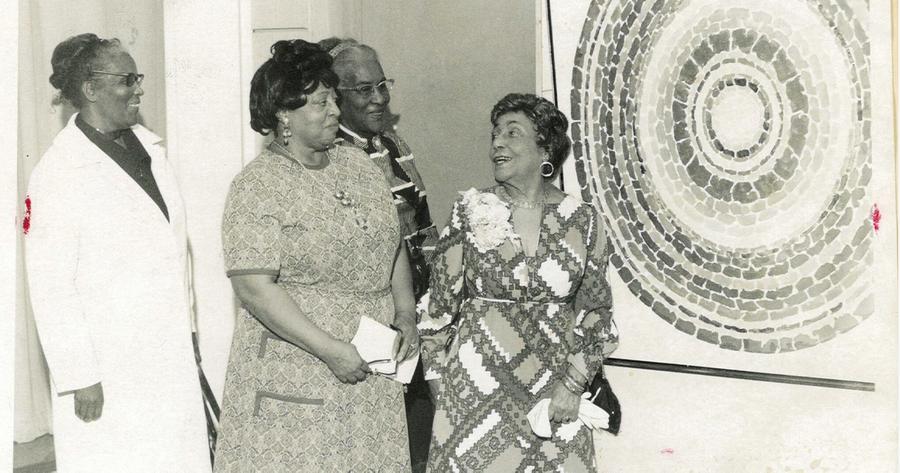
A new exhibition highlights the life and work of renowned artist Alma Thomas, a native of Columbus, Georgia. Alma Thomas rose to fame in 1972 at 80 years old as the first Black woman to have a solo show at the Whitney Museum in NYC; she was also the first African American woman to have her work added to the White House Collection.
The Columbus Museum in Georgia has opened Sand Unshaken: The Origin Story of Alma Thomas, an exclusive, historical exhibition that uses rare family artifacts to tell the story of one of the Chattahoochee Valley’s most famous and beloved artists. Sand Unshaken serves as an intriguing and informative opening act for Alma W. Thomas: Everything Is Beautiful, a collection of works that is set to come home to Columbus, Georgia, in July after stops in Norfolk, Washington, D.C. and Nashville.
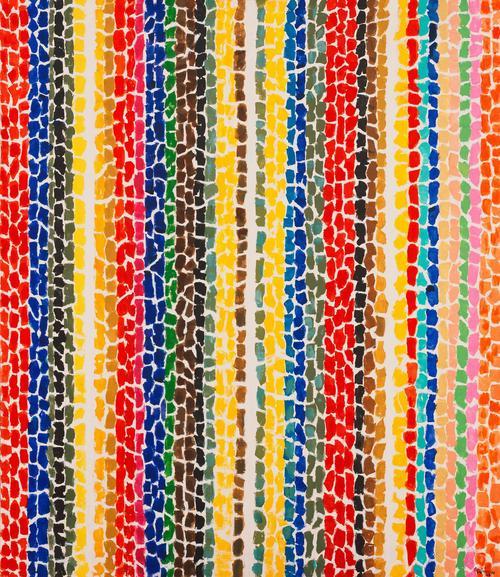
Art enthusiasts across the world have come to know and love the vibrant and inspirational works of the Columbus native, but few are aware of Thomas’s complicated and surprising history of growing up in the deep South in the decades following the Civil War. Sand Unshaken draws from the Thomas family archives in The Columbus Museum’s permanent collection to showcase the Thomas family’s life in Columbus through artifacts and family portraits.
“Sand Unshaken reveals a far more complex story about Alma Thomas and her family than is usually told,” said Rebecca Bush, Curator of History and Exhibitions Manager at The Columbus Museum. “Thomas experienced the racial discrimination that affected all African Americans in the Deep South during Jim Crow, but her family’s unique social position and determination to build a Black middle class offered her more opportunities than most of her peers. This exhibition provides insight into how Thomas’s childhood and family legacy in Columbus shaped her lifelong creativity.”
Among the historic artifacts featured in Sand Unshaken are family portraits, books, musical instruments used by family members, furnishings from the Thomas home in the upper-middle-class Rose Hill community, and a locket purchased by Thomas’s grandfather for her grandmother while both were enslaved.
Pieces included in the exhibition help to weave the story of the Thomases’ unusual life in Columbus. For example, Alma’s grandfather owned an expansive farm in the region and the juxtaposition of flower gardens and industrial landscapes near her home nurtured the young artist’s fascination with color. Her parents’ entrepreneurship and success as an in-demand dressmaker and Columbus’s first Black bar owner led to an elevated socioeconomic status, exposing the budding artist to civic organizations that helped build an understanding of community.
To complement the Sand Unshaken exhibition, The Columbus Museum has also developed a driving tour that includes 25 notable landmarks related to Alma Thomas and her family. Tour stops include the family home in Rose Hill, Lincoln Park, the historic site of St. John AME Church, Sixth Avenue School, John Thomas’s saloon and the passenger train depot, to name a few. A map detailing the full tour, including an eight-stop one-mile walking tour, can be found on The Columbus Museum’s exhibition website.
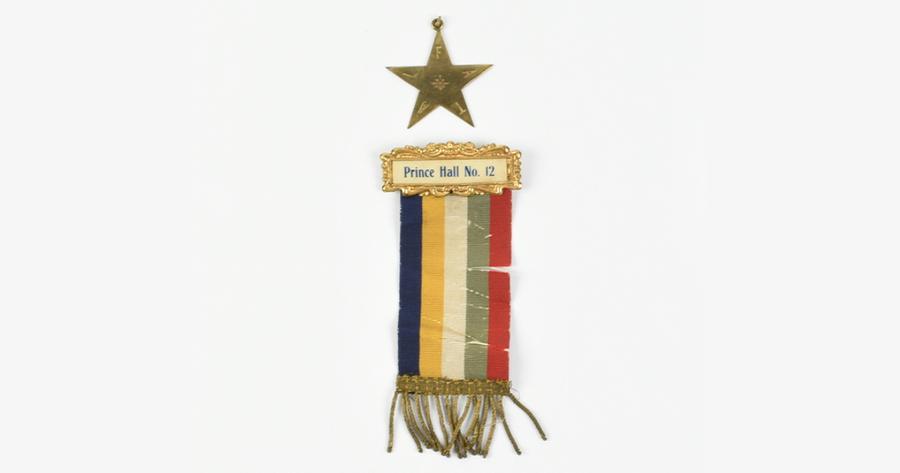
"Sand Unshaken: The Origin Story of Alma Thomas, on view only at The Columbus Museum, offers, for the first time, a comprehensive look at the lives of Alma Thomas and her family in the Chattahoochee Valley,” said Marianne Richter, Director of the Columbus Museum. “We are excited to share rarely seen objects from the Museum’s permanent collection, donated by the Thomas family, that offer insight into their experiences in Columbus, Thomas’s hometown.”
The Sand Unshaken exhibition will complement the landmark art exhibition Alma W. Thomas: Everything Is Beautiful, traveling to the Columbus Museum on July 1, 2022. The exhibition showcases a comprehensive overview of approximately 100 works from Thomas, including rarely seen theatrical designs and beloved abstract paintings.
The Sand Unshaken will be on view at The Columbus Museum from May 21 until October 2, 2022.
For more information on the upcoming exhibitions or to become a member of The Columbus Museum, visit ColumbusMuseum.com.



No comments:
Post a Comment